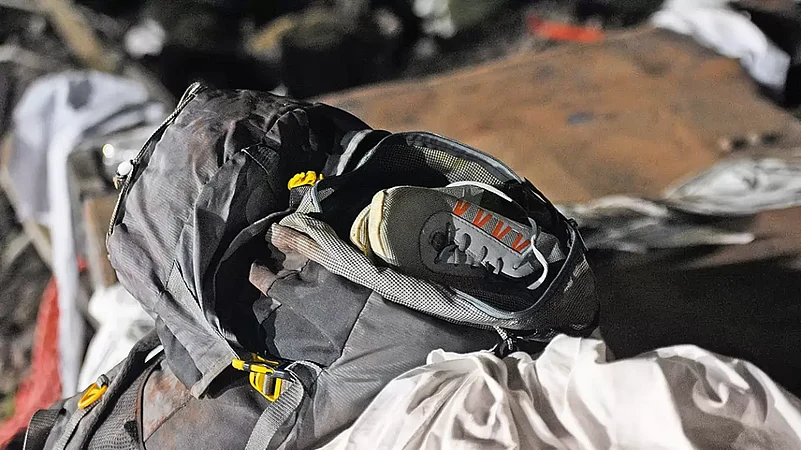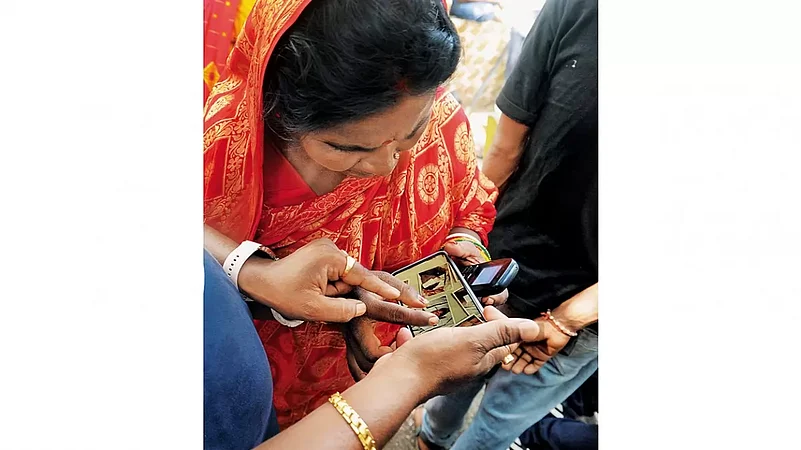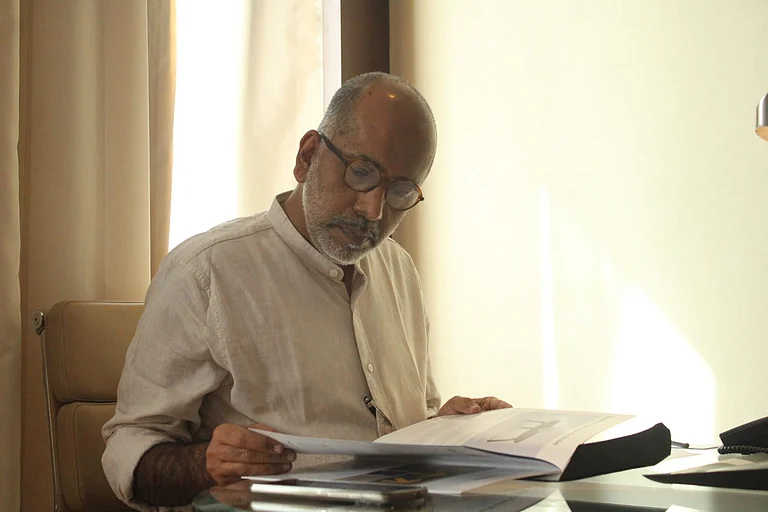It was a hot summer evening, and finding a seat next to the window meant a soothing, windy journey. The general compartment was crammed with people, but Ajodhi Paswan (42), his wife Usha (40), and their son Suraj (19) had found a quiet space. They were travelling from Bengaluru, where Ajodhi and Suraj worked as masons. Their excitement was inevitable as they were headed home to Musepur village in Bihar’s Samastipur district after more than a year.
But that summer evening was the last time the family was together. Their journey was cut short by the nightmarish train mishap in Odisha’s Balasore district on June 2—billed as one of the worst in Indian railway history. The accident left 288 dead and over 1,200 people were injured.
Twelve hours after the accident, Ajodhi and Usha were admitted with severe injuries in two different hospitals almost 180 km apart—both unaware about the whereabouts of their son. Three days later, Ajodhi and Usha were moved to a hospital in Samastipur, and are slowly recovering. But they still do not know whether their son is alive.
Ajodhi’s relatives, who travelled 700 km to look for Ajodhi and his family, returned to Samastipur on June 6 after a futile search for Suraj. “We were told Suraj was admitted to a hospital in Balasore. The hospital staff informed us that he was discharged and showed us his signature. The signature was in English and Suraj does not sign in English,” says Ajodhi’s uncle, Biswanath Paswan.
“When no hospital had an entry in the name of Suraj Paswan, we started visiting the morgues. We were told that an exhibition ground was being used as a morgue. The ground was divided into two parts—on one side, there were dead bodies wrapped in white sheets and stored in ice. But we weren’t allowed to go there,” says Biswanath. “We were then taken to the other side, where there was a big projector displaying images of those who had died. We were asked to identify Suraj from these images. Some faces had severe injuries and it was difficult to identify them. We could not identify Suraj in any of those images,” he adds. Ajodhi and Usha haven’t spoken to each other since the accident, but are hopeful that they will reunite with their son as soon as they recover.

The accident site was a reminder of shattered hopes and separated families. Amid the fragments of the trains, railway tracks strewn all over and the mangled remains of the rail coaches, there were also items of reminders left behind. A blood-soaked stole, a pile of backpacks, a shoe, and some scattered sheets of paper that treasured beautiful poems of love, and hand-painted images of elephants, fish and the sun. The palpable destruction now remains etched in the memories of the onlookers.
For two days after the accident, the Bahanaga Bazar railway station, in contrast to its quaint premises, saw a footfall of thousands of people. Vehicles parked at a stretch of at least two km from the accident site and a beeline of people on foot. Some people had travelled from as far away as 700 km to look for their loved ones, while others had travelled from nearby districts to witness the destruction. Some people offered help; some used mobile phones to share live visuals with their families; some were fixated on the helicopters that were flying in and out; and, others prayed amid all the media glare. Needless to say, the accident site attracted senior political leaders, including Prime Minister Narendra Modi and the Chief Ministers of Odisha and West Bengal.
A Political Slugfest
While the detailed inquiry report is yet to be submitted, a preliminary report by the Indian Railways suggests that the Coromandel Express, a long-distance train connecting West Bengal with Tamil Nadu, had entered the loop line and crashed into a goods train parked there, instead of going ahead on the main line. This led to the derailment of the train, which collided with the Bengaluru-Howrah Express approaching from the other end.
Interacting with the media at the accident site two days later, Railways Minister Ashwini Vaishnaw said: “The accident occurred because of a change in the electronic interlocking system. This system is an important device for railway signalling. The details will be shared after the report is submitted,” Vaishnaw said. The inquiry is being done by the Commissioner of Railway Safety (CRS), South Eastern Circle.

Other officials—Principal Executive Director of Signalling, Sandeep Mathur, and Member of Operation and Business Development, Jaya Varma Sinha—also explained how the accident might have happened. Refuting any error on the part of the train’s driver and ruling out over-speeding, they said that the possible cause of the accident was a signalling issue. “Green signal means that in every way the driver knows that his path ahead is clear and he can go forward with his permitted maximum speed. The permitted speed at this section is 130 kmph and he was running the train at 128 kmph which we have confirmed from loco logs,” Sinha said. “Only one train was involved in the accident, and it was the Coromandel Express. The Coromandel Express crashed with the goods train and its coaches went on top of the goods train. It was an iron ore-laden train, a heavy train, therefore, the entire impact of the collision was on the Coromandel Express,” she added.
Explaining the issue with the interlocking system, Mathur said, “Signal is interlocked in such a manner that it will show if the line ahead is occupied or not. It will also be known whether the point is taking the train straight or towards the loop line. When the point shows straight and the track ahead is not occupied, then the signal is green and if the point is taking the train on the loop line and the track is clear, then the signal is yellow and the route is shown in a different direction.”
Meanwhile, the Railway Board had also recommended a CBI inquiry into the matter, following which a case was registered by the CBI on June 6. A 10-member team of the probe agency also visited the accident site for further investigations. This came a day after the Government Railway Police (GRP) in Cuttack registered a case under Sections 153, 154, and 175 of the Railway Act against unknown persons. While the investigations are underway, the accident has also become one of the most politicised railway mishaps, with the opposition seeking Vaishnaw’s resignation. Mamata Banerjee has repeatedly questioned the number of fatalities and alleged that the accident was a result of an oversight by the railways. On June 4, she said, “The accident could have been averted had the railways installed an anti-collision device (Kavach). There is something suspicious in the case.”
The Congress party also issued a statement alleging criminal neglect of the signalling system despite multiple warnings. Demanding Vaishnaw’s resignation, the party said, “Prime Minister Narendra Modi, who has announced that the guilty would be punished, must first start with his railway minister. Unequivocally and unambiguously, we demand the resignation of the Union railway minister, Shri Ashwini Vaishnaw.”
The CBI probe was also questioned by the opposition alleging that the central probe agency is meant to investigate crimes and not railway accidents. “This shows the government has no intention to address the systemic safety malaise, but is, instead, finding diversionary tactics to derail any attempts to fix accountability,” said Congress President Mallikarjun Kharge.

The First Responders
Kiran Mallik (28), works at a shoe shop nearly 500 metres away from the Bahanaga Bazar railway station. “We first heard a huge sound. It was not the sound of an explosion, but it was loud and scary. Many of us left our shops and homes and ran towards the station,” Mallik said. “What we saw was beyond what we had imagined. As far as the eye could see, train coaches had derailed and toppled down from the tracks. At first glance, it was difficult to comprehend what had happened. The railway track was damaged, and there was a coach mounted on top of a goods train. Parts of the train coaches were scattered all across the tracks. It was a disaster,” he recalled. The local people who reached the spot immediately started evacuating people from the overturned coaches. But with limited light and wreckage all around, it was an uphill task. “There was very little light, so we couldn’t see anything. We used our phone torch to make our way. But people were screaming, and we followed their sounds to help them. Our hands and legs were shivering too as we approached the passengers,” said another local resident, Gyanbhyan Behera. “The place looked even worse at dawn. There were blood and blood-soaked belongings on the tracks. The screams had faded out, but we knew there were people. The rescue teams were pulling out body after body, some with even severed limbs and crushed faces,” Behera added.
Personnel from the State Disaster Response Force (SDRF) and the National Disaster Response Force (NDRF) from Balasore arrived at the spot, followed by six other teams from the NDRF. The rescue operation, which began at around 8 pm on June 2, went on for most of the next day. An upward temperatures of 30 + degrees, a constant rush of onlookers flocking to the site, and the magnitude of the wreckage, all added to the challenges.
“This experience was particularly harrowing. I have participated in flood relief and other natural calamities, but a rescue operation in a train accident was the first for me. I cannot forget the painful screams asking for help,” an NDRF personnel said on condition of anonymity.
The rescue operation went on for nearly 20 hours. The most challenging aspect was evacuating passengers stuck in coaches that were crushed beneath each other. “There were two such points where we had to use technical support and help from railway engineers to first separate the coaches and then evacuate people. After a point in time, we had lost hope of finding anyone alive,” he added.
The relief site had temporary tents for rescue personnel and paramedics, but they were occupied by every person looking for shade on a sultry day. After long hours of rescue operations, the personnel rested under heavy vehicles, inside the train coaches, or huddled under a solitary tree.
Immediately after the rescue operations, restoration of the rail tracks began. The two train lines were restored after almost 51 hours. “It was an interdepartmental task. We roped in officials from track engineering, electrical, and operations. All equipment was arranged, including a 40-tonne crane and porcelain machines for the task,” said Biswajit Sahoo from the East Coast Railway.
After the restoration, a coal-laden goods train from Vizag port rolled on the restored tracks towards the Rourkela Steel Plant. Following this, passenger trains were allowed to run on the main line connecting eastern and southern India.
A New Lease of Life
At the Srirama Chandra Bhanja (SCB) Medical College and Hospital in Cuttack, nearly 175 km from the accident site, the trauma centre is heavily guarded by police officials. The only people allowed inside are relatives of the accident survivors, political leaders, and other VIPs.
On the other side of the trauma centre is a help desk set up with seven landline phones. The relentless ringing since a day after the accident had faded out by Tuesday afternoon. The volunteers at the desk are equipped with a long list of patients who have been admitted. The list has the names of the patients and their ages. The volunteers, some of whom are even accompanying relatives inside the trauma centre, have now remembered some names by heart, some faces of plight marked in their minds.

The third floor of the trauma centre resonates with occasional screams of pain piercing through an otherwise eerie silence. Here, patients have been accommodated in the rooms, floors and even corridors. Occupying the extreme left corner bed of a room are 28-year-old P Suraj Sheikh and his friend Rajesh Sheikh (40). They had visited Bengaluru to appear for an interview for the post of airport security. They were on their way back home to Murshidabad district in West Bengal when the accident happened. “I had just spoken to my wife back home that I would reach home soon. We were eating some snacks when we felt some sort of turbulence. Before we could make sense of what had happened, we fell to the floor and the coach turned upside down. I couldn’t see anything. I could only hear screams. I was pulled out around three hours later and shifted to the hospital,” Suraj said. He has a head injury, and deep cuts on his shoulder, face and back.
Though he is yet to receive a confirmation for the job, he is sure about finding a job closer home. “I have elderly parents, a wife, and two kids to look after. The job would have ensured better education for my children at the least. But after this incident, I don’t think I ever want to be so far away from them,” he added.
Sameer Sheikh (25), has a fractured hand and a head injury and is admitted at the District Headquarters Hospital in Balasore district. Sameer’s father and elder brother work as blacksmiths in Murshidabad district. He was the first person in his family who had decided to leave his hometown and find work in a new city. A year ago, he moved to Bengaluru to work as a mason. He earned Rs 500-600 per day. But this incident has made his family determined to not send him away from home, ever again.
Recalling the accident, Sameer said, “I was traveling in the general compartment and had found a seat. First, something hit the window of our compartment. I don’t know whether it was a rock or part of the other coach. A few seconds later, the entire coach toppled down. I held on to the seat. The entire coach was upside down,” Sameer said. “There was blood around, people were screaming. I could see people crushed one over the other and withering in pain. Everybody was trying to make sense of what had happened and make their way out of the train,” he recalled.
Sameer was pulled out of the coach almost an hour after the accident by the local people. “I started walking towards the town and then I saw an ambulance and they took me in. I do not know how I survived,” he added.
Two friends, Mohammad Azad and Mohammad Imtiaz, both aged 17, were pulled out after 14 hours. Both of them sustained injuries on their heads and had broken limbs. They were traveling from Vijayawada where they work in a chemical company to their hometown in Howrah. “There was blood all around. We were stuck between people. We could not recognise who was dead or who was alive. It was dark. At some point, we could see torch flashes and would scream for help. The entire night felt like eternity….” Imtiaz said.
Frantic Search in Vain
“My brother could be token number 10,” said 27-year-old Koushik Mondal, pointing at the large LED screen at AIIMS, Bhubaneswar. On display are lifeless bodies, some identifiable, some beyond recognition. Close to the display are the same images placed on a desk. The images are accompanied by belongings, some with identity cards, and all with a unique identification number assigned to them.
Koushik had arrived in Balasore from Kolkata, covering 250 km, early on Saturday morning. He first learned about the accident on the news. He was aware that his younger brother, Sanjiv Mondal, was returning home on the same train. When desperate calls to Sanjiv yielded no results, Koushik immediately left home to look for his brother.
“I first reached the accident site because someone told me that rescue operations were still underway. My heart sank when I looked at the coaches piled up. I couldn’t breathe, just imagining if at all my brother was stuck in there,” he said. After almost two hours when he found nothing, he left. “The next day, I kept looking for him from one hospital to another. But I couldn’t find him. My parents back home kept calling me, and I had no answers to give,” he said.
On June 3, he also visited the Bahanaga high school, less than a km from the accident site, which was turned into a temporary mortuary. The school premises had helpless family members lined up close to the gate. The chairs and desks were haphazardly placed outside the classrooms as the rooms were filled with dead bodies.
The bodies were brought into the school in pick-up trucks on the same fateful night. By June 3, there were nearly 150 bodies placed inside the school classrooms. “Inside three rooms, there were piles of bodies wrapped in white sheets. But it was difficult to identify the bodies because the faces were covered. I waited in desperation along with other people outside the school,” Koushik said.
With the searing heat and non-operational fans, the bodies were eventually shifted to an air-conditioned building to avoid decomposition. By Sunday, the bodies were sent to Bhubaneswar and placed in mortuaries at AIIMS and two private hospitals.
On June 4, he went to the building to look at the pictures of the unidentified bodies. “The images were gut-wrenching. I looked at one image with the token number 10. His face was not clearly visible. But the face cut matched my brother’s. The hair looked similar. When we inquired further, we were told that he was taken to AIIMS. So we came here,” he said. Almost three hours after his arrival, his worst nightmare had come true. His brother was token number 10.
Deputy Commissioner of Bhubaneswar Municipal Corporation, Rajkishore Jena, explained that the number helps identify the body from any place. The same images were also uploaded on government-run websites for identification. “Once the body is recognised, we verify the identity and then hand it over to the family member. We are providing free transportation as well,” he said.
For over 48 hours, Soni Begum kept looking for her 22-year-old son, at hospitals and morgues. She had travelled all the way to Balasore from Murshidabad to look for her son, only to take his lifeless body back home. “I should have never let him leave home. I had made his favorite sweets because he was coming home after six months. He did not like the food there. I had promised to cook all his favourite food,” she said. “I was still hopeful that I would find him until I saw his body…” she said.
As of June 6, 205 bodies have been identified and handed over to their families; 83 bodies are yet to be identified. Many of those who were killed in the accident were from West Bengal and Bihar commuting in the general compartments of the train and headed towards southern cities for their livelihoods.
The Unidentified
The identification of the remaining victims, however, poses a challenge—instances of false claims, duplicate claims or no identification. To address this challenge, experts including anatomy and forensic experts from AIIMS, Nagpur, and AIIMS, Raipur, have been roped in to embalm the bodies and preserve them for more days until the identification process is completed. Provisions of DNA testing have also been made available for effective identification. “In certain cases, multiple people are claiming a single body and in some cases the identification just through images is impossible. DNA testing will be effective,” Executive Director of AIIMS, Bhubaneswar, Ashutosh Biswas told Outlook.
The Indian Railways is also using face recognition technology to match telecom databases. According to sources, the victims’ faces were matched with the profiles associated with their mobile numbers. “Our help desk has received incessant calls. In many cases, the names suggested by them do not match our database. They are unable to identify their family members even from the image database of those who died. In such cases, we have been connecting them to the mortuaries, to ascertain if the unidentified bodies could be their family members,” a help desk supervisor said. For many, the search continues, with a hope that it will end soon.
Aishwarya Mohanty is an independent journalist based in Bhubaneswar
(This appeared in the print as Tracks of Tragedy)





















